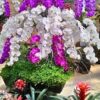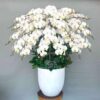# A Comprehensive Guide to Creating Unique Wall-Mounted Phalaenopsis Orchid Planters

Phalaenopsis orchids, commonly known as **Lan Hồ Điệp**, are renowned for their stunning blooms and graceful appearance. These tropical beauties can be showcased in many creative ways, and one of the most innovative methods is by creating wall-mounted planters. This approach not only saves space but also adds a striking vertical element to your decor. In this comprehensive guide, we will explore the steps to create unique wall-mounted Phalaenopsis orchid planters, from selecting the right materials to caring for your orchids.
## 1. Understanding Phalaenopsis Orchids
### 1.1 Characteristics of Phalaenopsis Orchids
Phalaenopsis orchids are known for their long-lasting blooms, wide range of colors, and elegant shapes. Here are some key characteristics:
– **Flowers**: They can have single or multiple blooms on a spike, which can last for several months.
– **Leaves**: The leaves are thick, fleshy, and typically dark green, providing a beautiful backdrop for the flowers.
– **Roots**: Phalaenopsis orchids have aerial roots that can absorb moisture and nutrients from the air.
### 1.2 Benefits of Wall-Mounted Planters
– **Space Saving**: Wall-mounted planters are perfect for small spaces, allowing you to create a beautiful display without taking up floor space.
– **Aesthetic Appeal**: These planters can enhance your interior design, adding texture and color to walls.
– **Improved Air Circulation**: Mounting orchids on walls can provide better air circulation around the plants, reducing the risk of diseases.
## 2. Choosing the Right Materials
### 2.1 Selecting Your Planter
When creating a wall-mounted planter for Phalaenopsis orchids, you have several material options:
– **Wooden Planters**: A rustic wooden planter can create a natural look. Ensure the wood is untreated to avoid harmful chemicals.
– **Wire Baskets**: These allow for good drainage and airflow. Line them with moss to retain moisture.
– **Ceramic or Clay Pots**: These can be mounted on the wall using brackets. Ensure they have drainage holes.
### 2.2 Additional Supplies
– **Mounting Hardware**: Use sturdy hooks, brackets, or wall mounts suitable for the weight of the planter.
– **Moss**: Sphagnum moss or coconut coir can help retain moisture for the roots.
– **Potting Mix**: A mix designed specifically for orchids, typically containing bark, charcoal, and perlite.
– **Decorative Elements**: Consider adding decorative stones, shells, or artful accents to enhance the aesthetic appeal.
## 3. Designing Your Wall Planter
### 3.1 Planning the Layout
Before you begin assembling, plan the layout of your wall-mounted planters:
– **Spacing**: Consider how far apart you want each planter. This allows for growth and airflow.
– **Height**: Ensure that the planters are at a height where you can easily access them for watering and maintenance.
– **Theme**: Decide if you want a uniform look (same type and color of planters) or a more eclectic design with various styles and colors.
### 3.2 Creating a Visual Design
– **Symmetry vs. Asymmetry**: Symmetrical arrangements can create a more formal look, while asymmetrical arrangements can feel more casual and modern.
– **Color Coordination**: Choose planters that complement the colors of your orchids and your overall decor.
## 4. Assembling the Wall-Mounted Planter
### 4.1 Preparing the Planter
– **Drainage**: Ensure your planter has adequate drainage holes. If using a non-draining planter, add a layer of gravel at the bottom to prevent root rot.
– **Lining**: If using wire baskets, line them with moss to retain moisture.
### 4.2 Planting the Phalaenopsis Orchids
1. **Remove the Orchid**: Gently take the orchid out of its original pot, taking care not to damage the roots.
2. **Trim Roots**: Inspect the roots for any dead or rotten parts and trim them as necessary.
3. **Place in Planter**: Position the orchid in the planter, ensuring the roots are spread out and not crammed.
4. **Add Potting Mix**: Fill in around the roots with the orchid potting mix, gently pressing it down to eliminate air pockets. Leave the crown of the plant exposed.
### 4.3 Mounting the Planter
1. **Mark the Wall**: Use a level to mark where the planter will hang.
2. **Install Mounting Hardware**: Securely install the mounting hardware according to the manufacturer’s instructions.
3. **Hang the Planter**: Carefully place the planter onto the mounted hardware, ensuring it is secure.
## 5. Care and Maintenance of Wall-Mounted Orchids
### 5.1 Watering
– **Frequency**: Water your Phalaenopsis orchids when the potting mix feels dry to the touch. This is typically every 7 to 10 days, depending on humidity levels.
– **Technique**: Use room-temperature water, and water thoroughly until it drains from the bottom. Avoid letting the plant sit in water.
### 5.2 Light Requirements
– **Lighting**: Phalaenopsis orchids thrive in bright, indirect sunlight. A location near a window with filtered light is ideal.
– **Rotation**: Rotate the planter periodically to ensure even growth, as the plant will lean toward the light.
### 5.3 Fertilization
– **Fertilizer Type**: Use a balanced orchid fertilizer diluted to half strength. Fertilize every two weeks during the growing season (spring and summer) and once a month during the dormant season (fall and winter).
– **Application**: Apply fertilizer after watering to avoid burning the roots.
### 5.4 Pruning and Repotting
– **Pruning**: After blooming, cut the flower spike back to promote new growth. Use sterilized scissors to prevent disease.
– **Repotting**: Plan to repot your orchids every 1-2 years to refresh the potting mix and accommodate growth.
## 6. Enhancing the Display
### 6.1 Adding Decorative Elements
– **Backgrounds**: Consider adding a painted canvas or decorative panel behind the planter for an artistic touch.
– **Lighting**: Use wall sconces or LED grow lights to highlight the orchids and enhance their beauty at night.
### 6.2 Grouping with Other Plants
– **Mixing Plants**: Create a living wall by grouping your Phalaenopsis orchids with other low-light plants, such as ferns or pothos.
– **Color Coordination**: Choose plants with complementary colors to create a visually appealing display.
## 7. Troubleshooting Common Issues
### 7.1 Yellowing Leaves
– **Causes**: Yellowing leaves may indicate overwatering or inadequate light.
– **Solutions**: Adjust your watering schedule and ensure the plant is receiving sufficient light.
### 7.2 Root Rot
– **Symptoms**: Soft, brown, or mushy roots are signs of root rot.
– **Solutions**: Remove the orchid from its planter, trim affected roots, and repot in fresh, dry potting mix.
### 7.3 Pest Infestation
– **Common Pests**: Watch for aphids, mealybugs, and scale insects.
– **Control Methods**: Use insecticidal soap or neem oil to treat infestations. Regularly inspect your orchids for signs of pests.
## 8. Conclusion
Creating a unique wall-mounted planter for your Phalaenopsis orchids not only showcases their stunning beauty but also allows you to make the most of your space. By following this comprehensive guide, you can design, assemble, and maintain a beautiful display that brings joy and elegance to your home or garden. With proper care and attention, your wall-mounted orchids will thrive, adding a touch of tropical charm to your living environment. Happy planting!

